4.4 Adulthood
The unfolding of our lives continues across the life span. It is, however, more difficult to generalize about adulthood stages than about life’s early years. If you know that James is a 1-
How old does a person have to be before you think of him or her as old? Depends on who you ask. For 18-
Physical Development
4-
Like the declining daylight after the summer solstice, our physical abilities—
“I am still learning.”
Michelangelo, 1560, at age 85
Physical Changes in Middle Adulthood
Athletes over age 40 know all too well that physical decline gradually accelerates. During early and middle adulthood, physical vigor has less to do with age than with a person’s health and exercise habits. Many of today’s physically fit 50-

menopause the time of natural cessation of menstruation; also refers to the biological changes a woman experiences as her ability to reproduce declines.
Aging also brings a gradual decline in fertility, especially for women. For a 35-
With age, sexual activity lessens. Nevertheless, most men and women remain capable of satisfying sexual activity, and most express satisfaction with their sex life. This was true of 70 percent of Canadians surveyed (ages 40 to 64) and 75 percent of Finns (ages 65 to 74) (Kontula & Haavio-
Physical Changes in Late Adulthood
Is old age “more to be feared than death” (Juvenal, The Satires)? Or is life “most delightful when it is on the downward slope” (Seneca, Epistulae ad Lucilium)? What is it like to grow old?

SENSORY ABILITIES, STRENGTH, AND STAMINA Although physical decline begins in early adulthood, we are not usually acutely aware of it until later in life, when the stairs get steeper, the print gets smaller, and other people seem to mumble more. Muscle strength, reaction time, and stamina diminish in late adulthood. As a lifelong basketball player, I [DM] find myself increasingly not racing for that loose ball. But even diminished vigor is sufficient for normal activities.
“For some reason, possibly to save ink, the restaurants had started printing their menus in letters the height of bacteria.”
Dave Barry,
Dave Barry Turns Fifty, 1998
With age, visual sharpness diminishes, as does distance perception and adaptation to light-
The senses of smell and hearing also diminish. In Wales, teens’ loitering around a convenience store has been discouraged by a device that emits an aversive high-
Most stairway falls taken by older people occur on the top step, precisely where the person typically descends from a window-
HEALTH As people age, they care less about what their bodies look like and more about how their bodies function. For those growing older, there is both bad and good news about health. The bad news: The body’s disease-
THE AGING BRAIN Up to the teen years, we process information with greater and greater speed (Fry & Hale, 1996; Kail, 1991). But compared with teens and young adults, older people take a bit more time to react, to solve perceptual puzzles, even to remember names (Bashore et al., 1997; Verhaeghen & Salthouse, 1997). The neural processing lag is greatest on complex tasks (Cerella, 1985; Poon, 1987). At video games, most 70-
Slower neural processing combined with diminished sensory abilities can increase accident risks. As FIGURE 4.18 indicates, fatal accident rates per mile driven increase sharply after age 75. By age 85, they exceed the 16-
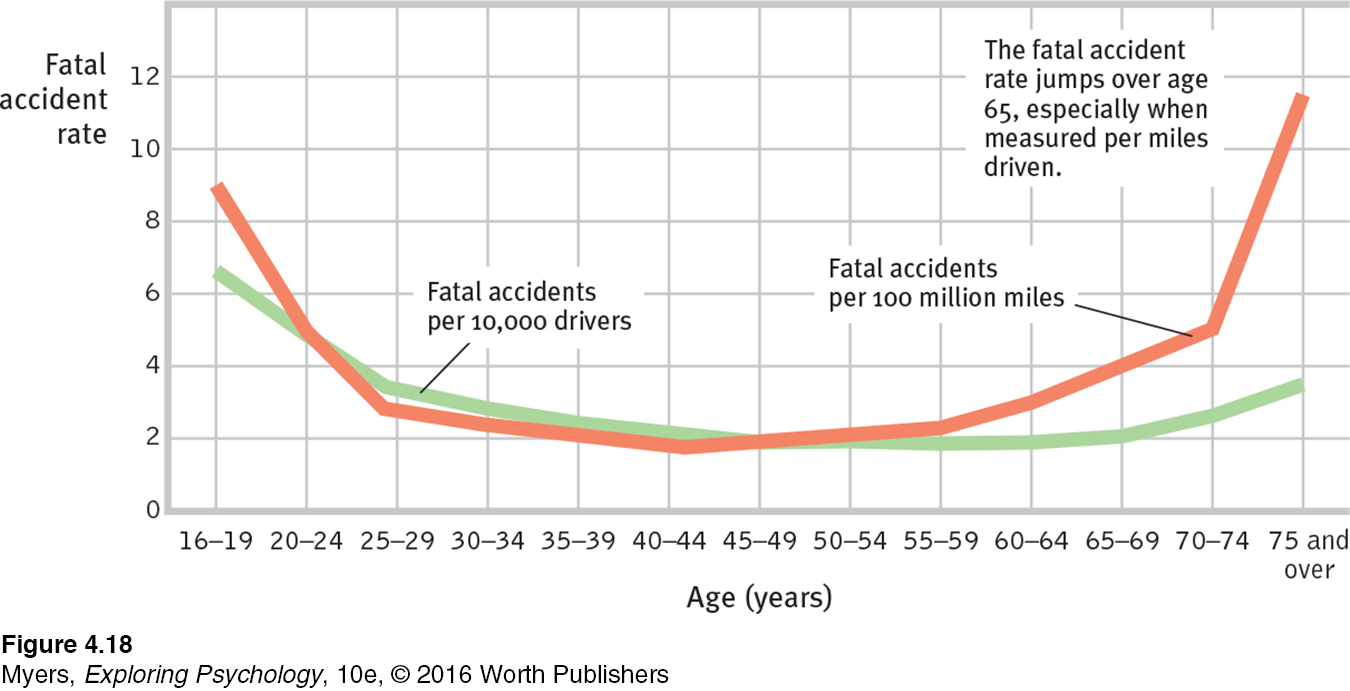
Brain regions important to memory begin to atrophy during aging (Fraser et al., 2015; Schacter, 1996). The blood-
EXERCISE AND AGING Exercise helps counteract some effects of aging. Physical exercise not only enhances muscles, bones, and energy and helps to prevent obesity and heart disease, it also stimulates brain cell development and neural connections, thanks perhaps to increased oxygen and nutrient flow (Erickson et al., 2013; Fleischman et al., 2015; Pereira et al., 2007). Exercise aids memory by stimulating the development of neural connections and by promoting neurogenesis, the birth of new hippocampus nerve cells. And it increases the cellular mitochondria that help power both muscles and brain cells (Steiner et al., 2011).
Sedentary older adults randomly assigned to aerobic exercise programs exhibit enhanced memory, sharpened judgment, and reduced risk of significant cognitive decline (DeFina et al., 2013; Liang et al., 2010; Nagamatsu et al., 2013). Exercise also helps maintain the telomeres (Leslie, 2011). These tips of chromosomes wear down with age, much as the end of a shoelace frays. Telomere wear and tear is accelerated by smoking, obesity, and stress. Children who suffer frequent abuse or bullying exhibit shortened telomeres as biological scars (Shalev et al., 2013). As telomeres shorten, aging cells may die without being replaced by perfect genetic replicas (Epel, 2009).
The message is clear: We are more likely to rust from disuse than to wear out from overuse. Fit bodies support fit minds.
Cognitive Development
Aging and Memory
4-
Among the most intriguing developmental psychology questions is whether adult cognitive abilities, such as memory, intelligence, and creativity, parallel the gradually accelerating decline of physical abilities.
As we age, we remember some things well. Looking back in later life, adults asked to recall the one or two most important events over the last half-
Early adulthood is indeed a peak time for some types of learning and remembering. In one test of recall, people watched video clips as 14 strangers said their names, using a common format: “Hi, I’m Larry” (Crook & West, 1990). Then those strangers reappeared and gave additional details. For example, they said, “I’m from Philadelphia,” providing more visual and voice cues for remembering the person’s name. As FIGURE 4.19 shows, after a second and third replay of the introductions, everyone remembered more names, but younger adults consistently surpassed older adults. How well older people remember depends in part on the task. In another experiment, when asked to recognize 24 words they had earlier tried to memorize, people showed only a minimal decline in memory. When asked to recall that information without clues, however, the decline was greater (FIGURE 4.20).

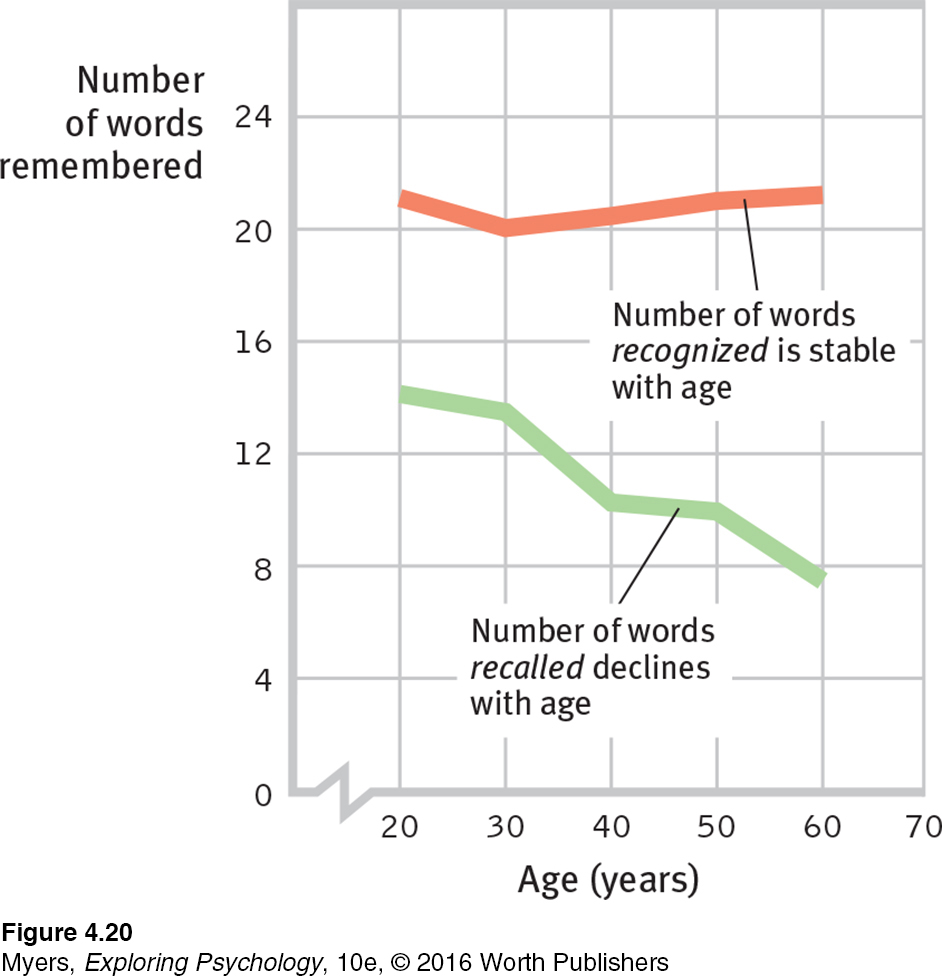
In our capacity to learn and remember, as in other areas of development, we show individual differences. Younger adults vary in their abilities to learn and remember, but 70-
No matter how quick or slow we are, remembering seems also to depend on the type of information we are trying to retrieve. If the information is meaningless—
Sustaining Mental Abilities
Psychologists who study the aging mind debate whether “brain fitness” computer training programs can build mental muscles and stave off cognitive decline. Our brains remain plastic throughout life (Gutchess, 2014). So, can exercising our brains on a “cognitive treadmill”—with memory, visual tracking, and problem-
 See LaunchPad's Video: Longitudinal and Cross-
See LaunchPad's Video: Longitudinal and Cross-
Based on such findings, some computer game makers are marketing daily brain-
cross-sectional study a study in which people of different ages are compared with one another.
longitudinal study research in which the same people are restudied and retested over a long period.
Chapter 9 explores another dimension of cognitive development: intelligence. As we will see, cross-sectional studies (comparing people of different ages) and longitudinal studies (restudying the same people over time) have identified mental abilities that do and do not change as people age. Age is less a predictor of memory and intelligence than is proximity to death. Tell us whether someone is 8 months or 8 years from a natural death and, regardless of age, you’ve given us a clue to that person’s mental ability. In the last three or four years of life and especially as death approaches, cognitive decline typically accelerates, and negative feelings increase (Vogel et al., 2013; Wilson et al., 2007). Researchers call this near-
“The sudden knowledge of the fragility of his life narrowed his focus and altered his desires. . . . It made him visit with his grandchildren more often, put in an extra trip to see his family in India, and tamp down new ventures.”
Atul Gawande, Being Mortal: Medicine and What Matters in the End, 2014, describing his father’s terminal condition and the way it changed his perspective
Social Development
4-
Many differences between younger and older adults are created by significant life events. A new job means new relationships, new expectations, and new demands. Marriage brings the joy of intimacy and the stress of merging two lives. The three years surrounding the birth of a child bring increased life satisfaction for most parents (Dyrdal & Lucas, 2011). The death of a loved one creates an irreplaceable loss. Do these adult life events shape a sequence of life changes?
Adulthood’s Ages and Stages
As people enter their forties, they undergo a transition to middle adulthood, a time when they realize that life will soon be mostly behind instead of ahead of them. Some psychologists have argued that for many the midlife transition is a crisis, a time of great struggle, regret, or even feeling struck down by life. The popular image of the midlife crisis is an early-
For the 1 in 4 adults who report experiencing a life crisis, the trigger is not age but a major event, such as illness, divorce, or job loss (Lachman, 2004). Some middle-
social clock the culturally preferred timing of social events such as marriage, parenthood, and retirement.
Life events trigger transitions to new life stages at varying ages. The social clock—the definition of “the right time” to leave home, get a job, marry, have children, or retire—
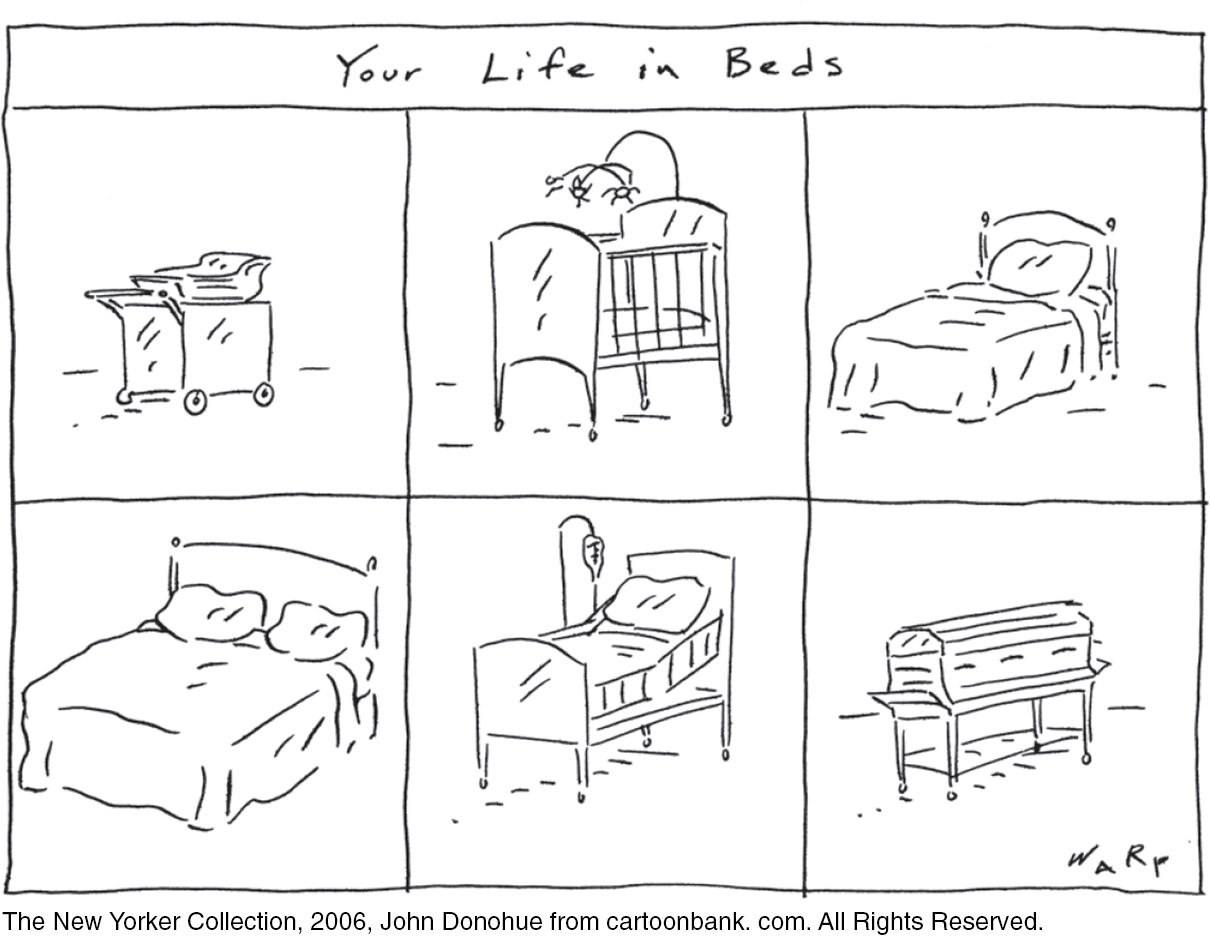
Even chance events can have lasting significance, by deflecting us down one road rather than another. Albert Bandura (1982, 2005) recalls the ironic true story of a book editor who came to one of Bandura’s lectures on the “Psychology of Chance Encounters and Life Paths”—and ended up marrying the woman who happened to sit next to him. The sequence that led to my [DM] authoring this book (which was not my idea) began with my being seated near, and getting to know, a distinguished colleague at an international conference. The road to my [ND] co-
“The important events of a person’s life are the products of chains of highly improbable occurrences.”
Joseph Traub, “Traub’s Law,” 2003
Adulthood’s Commitments
Two basic aspects of our lives dominate adulthood. Erik Erikson called them intimacy (forming close relationships) and generativity (being productive and supporting future generations). Sigmund Freud (1935/1960) put this more simply: The healthy adult, he said, is one who can love and work.
LOVE We typically flirt, fall in love, and commit—

Adult bonds of love are most satisfying and enduring when marked by a similarity of interests and values, a sharing of emotional and material support, and intimate self-
Historically, couples have met at school, on the job, through family, or, especially, through friends. Since the advent of the Internet, such matchmaking has been supplemented by a striking rise in couples who meet online—

Might test-
Although there is more variety in relationships today, the institution of marriage endures. Ninety-
What do you think? Does marriage correlate with happiness because marital support and intimacy breed happiness, because happy people more often marry and stay married, or both?
Relationships that last are not always devoid of conflict. Some couples fight but also shower each other with affection. Other couples never raise their voices yet also seldom praise each other or nuzzle. Both styles can last. After observing the interactions of 2000 couples, John Gottman (1994) reported one indicator of marital success: at least a five-
“Our love for children is so unlike any other human emotion. I fell in love with my babies so quickly and profoundly, almost completely independently of their particular qualities. And yet 20 years later I was (more or less) happy to see them go—
Developmental psychologist Alison Gopnik, “The Supreme Infant,” 2010
Often, love bears children. For most people, this most enduring of life changes is a happy event—
When children begin to absorb time, money, and emotional energy, satisfaction with the marriage itself may decline (Doss et al., 2009). This is especially likely among employed women who, more than they expected, may carry the traditional burden of doing the chores at home. Putting effort into creating an equitable relationship can thus pay double dividends: greater satisfaction, which breeds better parent-
“To understand your parents’ love, bear your own children.”
Chinese proverb

 IMMERSIVE LEARNING To explore the connection between parenting and happiness, visit LaunchPad’s How Would You Know If Having Children Relates to Being Happier?
IMMERSIVE LEARNING To explore the connection between parenting and happiness, visit LaunchPad’s How Would You Know If Having Children Relates to Being Happier?
Although love bears children, children eventually leave home. This departure is a significant and sometimes difficult event. For most people, however, an empty nest is a happy place (Adelmann et al., 1989; Gorchoff et al., 2008). Many parents experience a “postlaunch honeymoon,” especially if they maintain close relationships with their children (White & Edwards, 1990). As Daniel Gilbert (2006) has said, “The only known symptom of ‘empty nest syndrome’ is increased smiling.”
WORK For many adults, the answer to “Who are you?” depends a great deal on the answer to “What do you do?” For women and men, choosing a career path is difficult, especially during bad economic times. Even in the best of times, few students in their first two years of college or university can predict their later careers.

In the end, happiness is about having work that fits your interests and provides you with a sense of competence and accomplishment. It is having a close, supportive companion who cheers your accomplishments (Gable et al., 2006). And for some, it includes having children who love you and whom you love and feel proud of.
For more on work, including discovering your own strengths, see Appendix B: Psychology at Work.
RETRIEVE IT
Question
Freud defined the healthy adult as one who is able to and to .
Well-Being Across the Life Span
4-19 How does our well-being change across the life span?
To live is to grow older. This moment marks the oldest you have ever been and the youngest you will henceforth be. That means we all can look back with satisfaction or regret, and forward with hope or dread. When asked what they would have done differently if they could relive their lives, people’s most common answer has been “taken my education more seriously and worked harder at it” (Kinnier & Metha, 1989; Roese & Summerville, 2005). Other regrets—
“When you were born, you cried and the world rejoiced. Live your life in a manner so that when you die the world cries and you rejoice.”
Native American proverb
From the teens to midlife, people typically experience a strengthening sense of identity, confidence, and self-esteem (Huang, 2010; Robins & Trzesniewski, 2005). In later life, challenges arise: Income shrinks. Work is often taken away. The body deteriorates. Recall fades. Energy wanes. Family members and friends die or move away. The great enemy, death, looms ever closer. And for those in the terminal decline phase, life satisfaction does decline as death approaches (Gerstorf et al., 2008).
Prior to the very end, however, Gallup researchers have discovered that the over-
“Still married after all these years?
No mystery.
We are each other’s habit,
And each other’s history.”
Judith Viorst,
“The Secret of Staying Married,” 2007
Compared with teens and young adults, older adults tend to have a smaller social network, with fewer friendships (Wrzus et al., 2012). Like people of all ages, older adults are, however, happiest when not alone (FIGURE 4.22). Older adults experience fewer problems in their relationships—
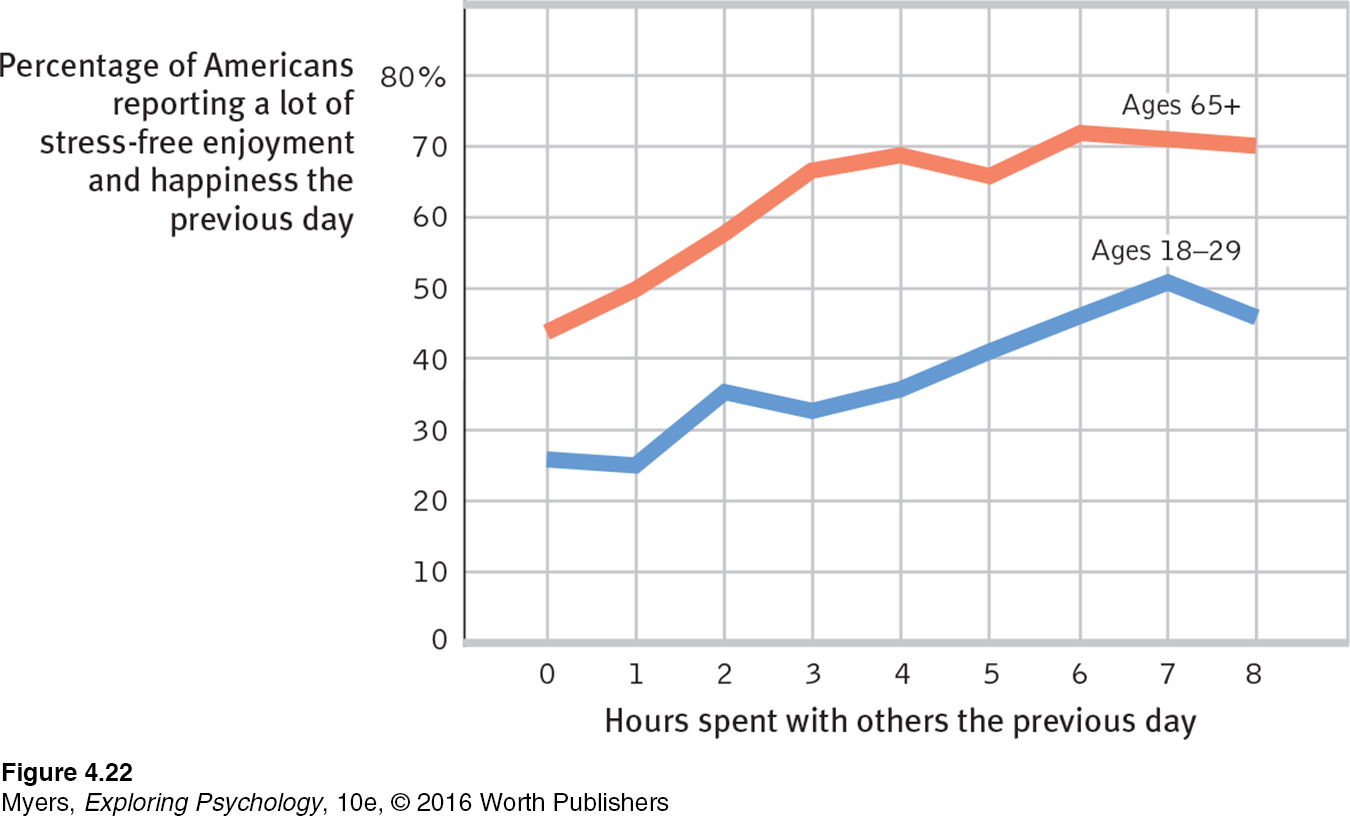
“At 20 we worry about what others think of us. At 40 we don’t care what others think of us. At 60 we discover they haven’t been thinking about us at all.”
Anonymous
The aging brain may help nurture these positive feelings. Brain scans of older adults show that the amygdala, a neural processing center for emotions, responds less actively to negative events (but not to positive events) (Mather et al., 2004). Brain-
“The best thing about being 100 is no peer pressure.”
Lewis W. Kuester, 2005,
on turning 100
Moreover, at all ages, the bad feelings we associate with negative events fade faster than do the good feelings we associate with positive events (Walker et al., 2003). This leaves most older people with the comforting feeling that life, on balance, has been mostly good. Thanks to biological, psychological, and social-
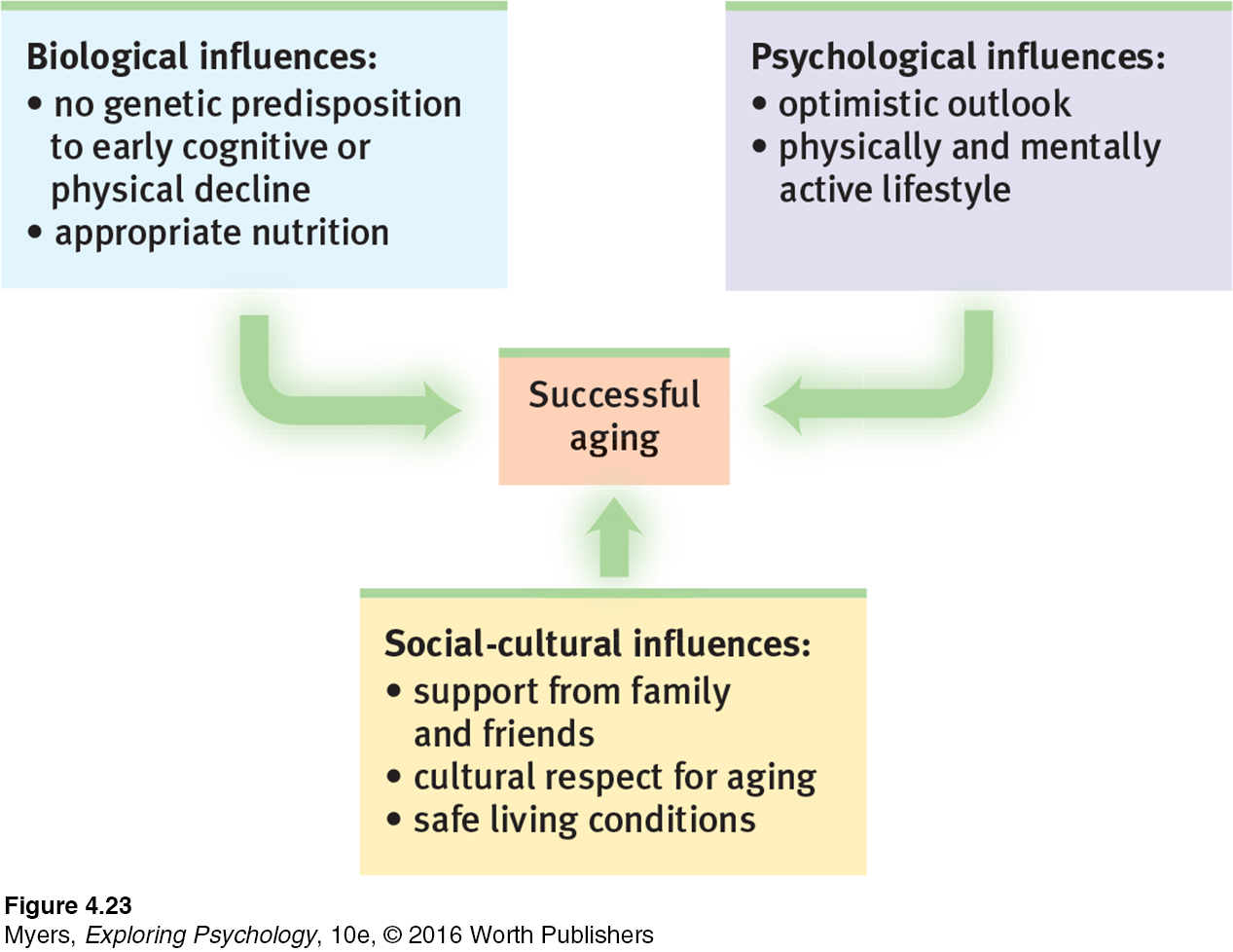
RETRIEVE IT
Question
What are some of the most significant challenges and rewards of growing old?
Death and Dying
4-
Warning: If you begin reading the next paragraph, you will die.
But of course, if you hadn’t read this, you would still die in due time. “Time is a great teacher,” noted the nineteenth-
“Love—
Brian Moore,
The Luck of Ginger Coffey, 1960
Most of us will also suffer and cope with the deaths of relatives and friends. For most people, the most difficult separation they will experience is the death of a spouse—
For some, however, the loss is unbearable. One Danish long-
Even so, reactions to a loved one’s death range more widely than most suppose. Some cultures encourage public weeping and wailing; others hide grief. Within any culture, individuals differ. Given similar losses, some people grieve hard and long, others less so (Ott et al., 2007). Contrary to popular misconceptions, however:
terminally ill and bereaved people do not go through identical predictable stages, such as denial before anger (Friedman & James, 2008; Nolen-
Hoeksema & Larson, 1999). those who express the strongest grief immediately do not purge their grief more quickly (Bonanno & Kaltman, 1999; Wortman & Silver, 1989). However, grieving parents who try to protect their partner by “staying strong” and not discussing their child’s death may actually prolong the grieving (Stroebe et al., 2013).
bereavement therapy and self-
help groups offer support, but there is similar healing power in the passing of time, the support of friends, and the act of giving support and help to others (Baddeley & Singer, 2009; Brown et al., 2008; Neimeyer & Currier, 2009). Grieving spouses who talk often with others or receive grief counseling adjust about as well as those who grieve more privately (Bonanno, 2004; Stroebe et al., 2005).
“Consider, friend, as you pass by, as you are now, so once was I. As I am now, you too shall be. Prepare, therefore, to follow me.”
Scottish tombstone epitaph
Facing death with dignity and openness helps people complete the life cycle with a sense of life’s meaningfulness and unity—
REVIEW Adulthood
Learning Objectives
Test Yourself by taking a moment to answer each of these Learning Objective Questions (repeated here from within the chapter). Research suggests that trying to answer these questions on your own will improve your long-
Question
4-
Question
4-
Question
4-
Question
4-
Question
4-
Terms and Concepts to Remember
Test yourself on these terms.
Question
menopause (p. 158) cross- longitudinal study (p. 162) social clock (p. 163) | a study in which people of different ages are compared with one another. research in which the same people are restudied and retested over a long period. the time of natural cessation of menstruation; also refers to the biological changes a woman experiences as her ability to reproduce declines. the culturally preferred timing of social events such as marriage, parenthood, and retirement. |
Experience the Testing Effect
Test yourself repeatedly throughout your studies. This will not only help you figure out what you know and don’t know; the testing itself will help you learn and remember the information more effectively thanks to the testing effect.
Question 4.18
1. By age 65, a person would be most likely to experience a cognitive decline in the ability to
| A. |
| B. |
| C. |
| D. |
Question 4.19
2. How do cross-
Question 4.20
3. Freud defined the healthy adult as one who is able to love and work. Erikson agreed, observing that the adult struggles to attain intimacy and .
Question 4.21
4. Contrary to what many people assume,
| A. |
| B. |
| C. |
| D. |
Use  to create your personalized study plan, which will direct you to the resources that will help you most in
to create your personalized study plan, which will direct you to the resources that will help you most in  .
.